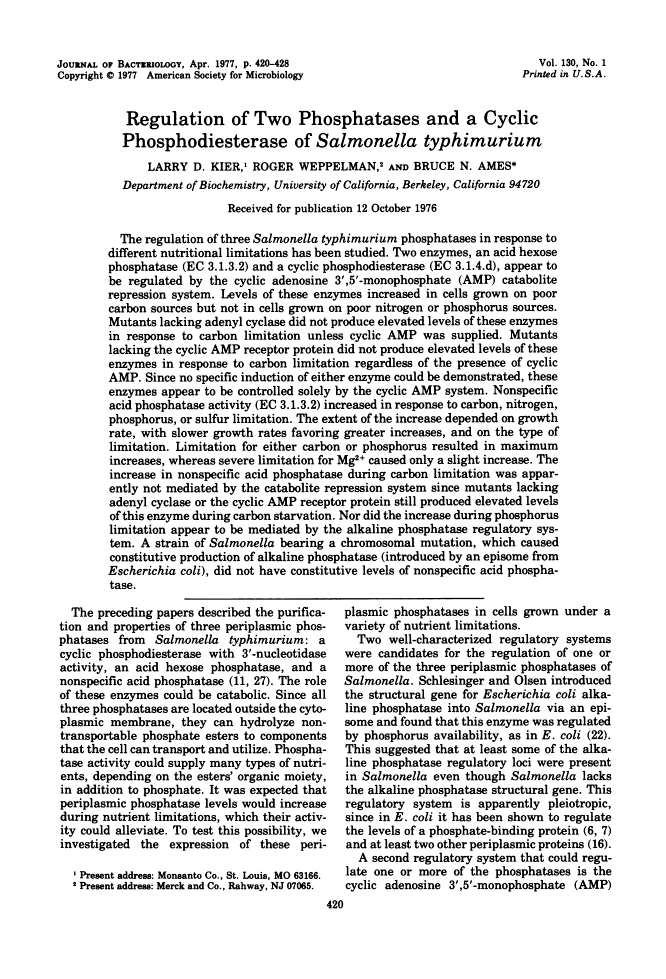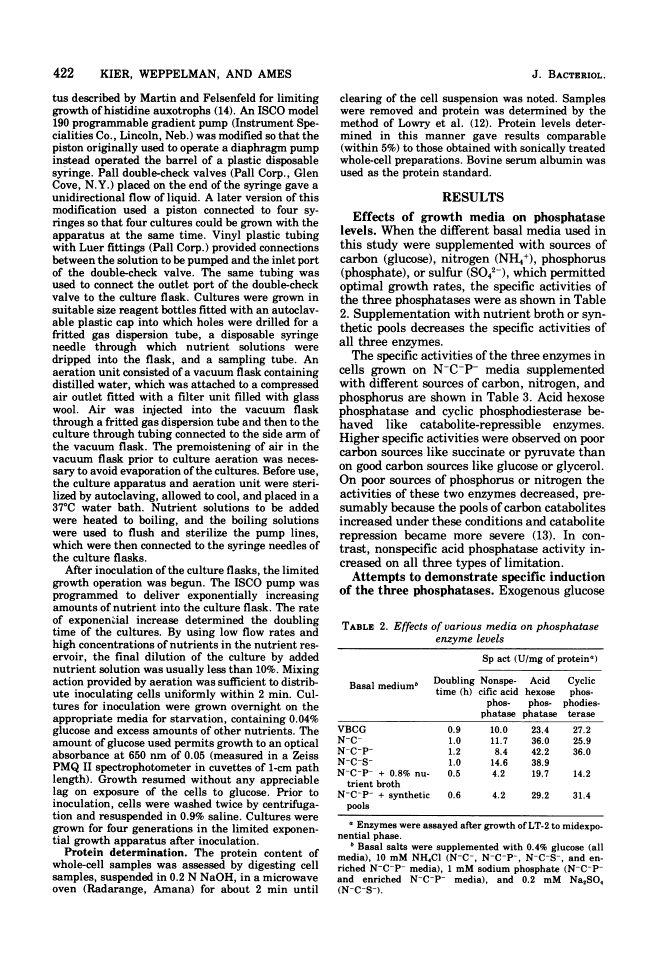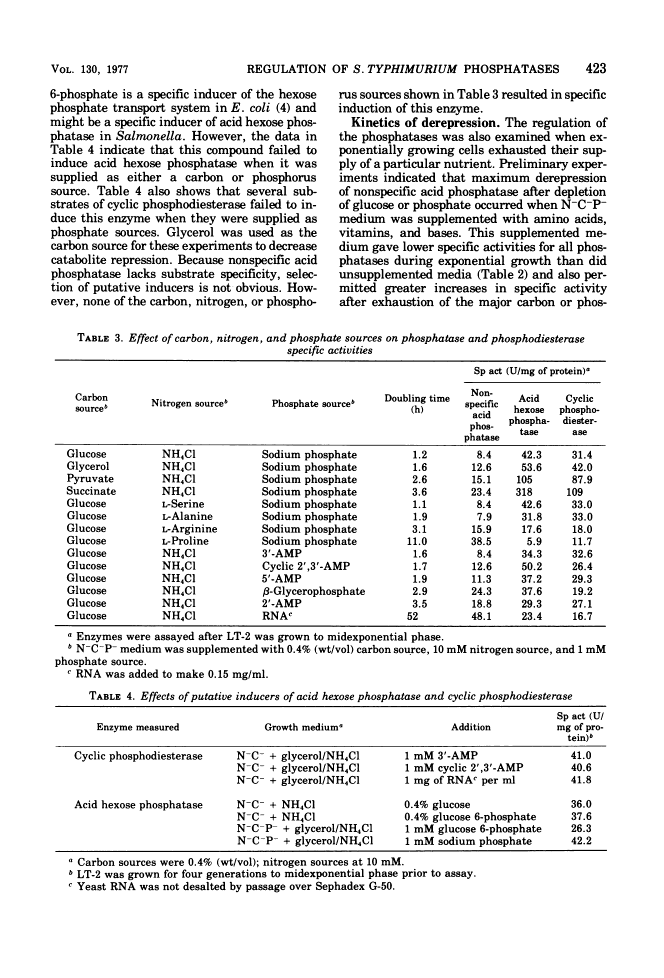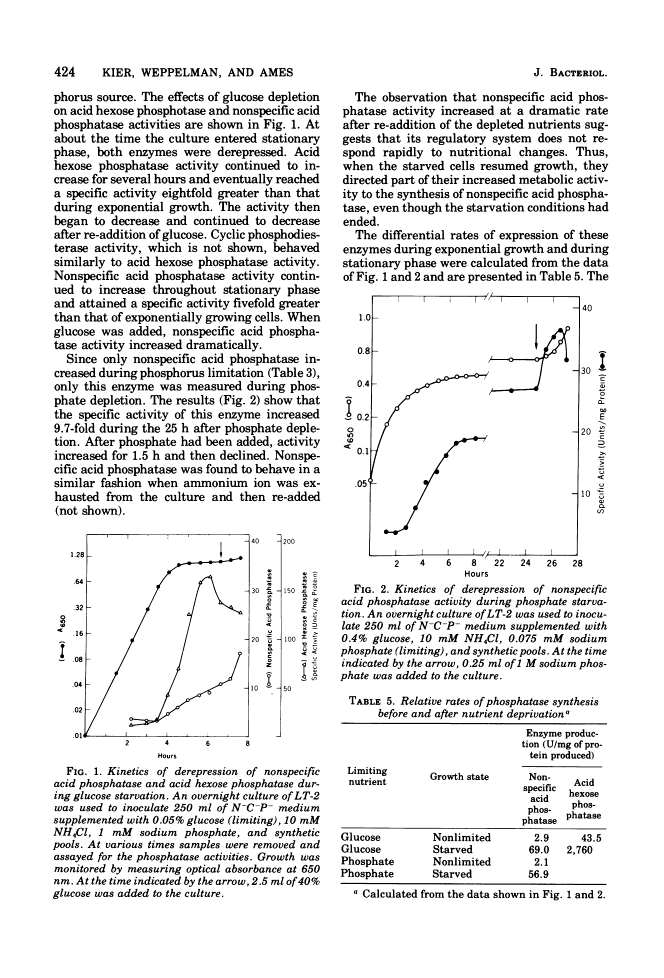Abstract
Free full text

Regulation of two phosphatases and a cyclic phosphodiesterase of Salmonella typhimurium.
Abstract
The regulation of three Salmonella typhimurium phosphatases in reponse to different nutritional limitations has been studied. Two enzymes, an acid hexose phosphatase (EC 3.1.3.2) and a cyclic phosphodiesterase (EC 3.1.4.d), appear to be regulated by the cyclic adenosine 3' ,5'-monophosphate (AMP) catabolite repression system. Levels of these enzymes increased in cells grown on poor carbon sources but not in cells grown on poor nitrogen or phosphorus sources. Mutants lacking adenyl cyclase did not produce elevated levels of these enzymes in response to carbon limitation unless cyclic AMP was supplied. Mutants lacking the cyclic AMP receptor protein did not produce elevated levels of these enzymes in response to carbon limitation regardless of the presence of cyclic AMP. Since no specific induction of either enzyme could be demonstrated, these enzymes appear to be controlled solely by the cyclic AMP system. Nonspecific acid phsphatase activity (EC 3.1.3.2) increased in response to carbon, nitrogen, phosphorus, or sulfur limitation. The extent of the increase depended on growth rate, with slower growth rates favoring greater increases, and on the type of limitation. Limitation for either carbon or phosphorus resulted in maximum increases, whereas severe limitation of Mg2+ caused only a slight increase. The increase in nonspecific acid phosphatase during carbon limitation was apparently not mediated by the catabolite repression system since mutants lacking adenyl cyclase or the cyclic AMP receptor protein still produced elevated levels of this enzyme during carbon starvation. Nor did the increase during phosphorus limitation appear to be mediated by the alkaline phosphatase regulatory system. A strain of Salmonella bearing a chromosomal mutation, which caused constitutive production of alkaline phosphatase (introduced by an episome from Escherichia coli), did not have constitutive levels of nonspecific acid phosphatase.
Full text
Full text is available as a scanned copy of the original print version. Get a printable copy (PDF file) of the complete article (1.4M), or click on a page image below to browse page by page. Links to PubMed are also available for Selected References.
Selected References
These references are in PubMed. This may not be the complete list of references from this article.
- Bolton PG, Dean AC. Phosphatase synthesis in Klebsiella (aerobacter) aerogenes growing in continuous culture. Biochem J. 1972 Mar;127(1):87–96. [Europe PMC free article] [Abstract] [Google Scholar]
- Carrillo-Castañeda G, Ortega MV. Effect of inorganic phosphate upon Salmonella typhimurium phosphatase activities: non-respressible alkaline phosphatase and non-inhibited acid phosphatase. Biochim Biophys Acta. 1967;146(2):535–543. [Abstract] [Google Scholar]
- De Crombrugghe B, Pastan I, Shaw WV, Rosner JL. Stimulation by cyclic AMP and ppGpp of chloramphenicol acetyl transferase synthesis. Nat New Biol. 1973 Feb 21;241(112):237–239. [Abstract] [Google Scholar]
- Dietz GW, Heppel LA. Studies on the uptake of hexose phosphates. II. The induction of the glucose 6-phosphate transport system by exogenous but not by endogenously formed glucose 6-phosphate. J Biol Chem. 1971 May 10;246(9):2885–2890. [Abstract] [Google Scholar]
- Dvorak HF, Brockman RW, Heppel LA. Purification and properties of two acid phosphatase fractions isolated from osmotic shock fluid of Escherichia coli. Biochemistry. 1967 Jun;6(6):1743–1751. [Abstract] [Google Scholar]
- GAREN A, OTSUJI N. ISOLATION OF A PROTEIN SPECIFIED BY A REGULATOR GENE. J Mol Biol. 1964 Jun;8:841–852. [Abstract] [Google Scholar]
- Gerdes RG, Rosenberg H. The relationship between the phosphate-binding protein and a regulator gene product from Escherichia coli. Biochim Biophys Acta. 1974 May 10;351(1):77–86. [Abstract] [Google Scholar]
- Goldberg AL, Howell EM, Li JB, Martel SB, Prouty WF. Physiological significance of protein degradation in animal and bacterial cells. Fed Proc. 1974 Apr;33(4):1112–1120. [Abstract] [Google Scholar]
- Hanson MA, Marzluf GA. Control of the synthesis of a single enzyme by multiple regulatory circuits in Neurospora crassa. Proc Natl Acad Sci U S A. 1975 Apr;72(4):1240–1244. [Europe PMC free article] [Abstract] [Google Scholar]
- Hong JS, Smith GR, Ames BN. Adenosine 3':5'-cyclic monophosphate concentration in the bacterial host regulates the viral decision between lysogeny and lysis. Proc Natl Acad Sci U S A. 1971 Sep;68(9):2258–2262. [Europe PMC free article] [Abstract] [Google Scholar]
- Kier LD, Weppelman R, Ames BN. Resolution and purification of three periplasmic phosphatases of Salmonella typhimurium. J Bacteriol. 1977 Apr;130(1):399–410. [Europe PMC free article] [Abstract] [Google Scholar]
- LOWRY OH, ROSEBROUGH NJ, FARR AL, RANDALL RJ. Protein measurement with the Folin phenol reagent. J Biol Chem. 1951 Nov;193(1):265–275. [Abstract] [Google Scholar]
- MARTIN RG, FELSENFELD G. A NEW DEVICE FOR CONTROLLING THE GROWTH RATE OF MICROORGANISMS: THE EXPONENTIAL GRADIENT GENERATOR. Anal Biochem. 1964 May;8:43–53. [Abstract] [Google Scholar]
- Morris H, Schlesinger MJ, Bracha M, Yagil E. Pleiotropic effects of mutations involved in the regulation of Escherichia coli K-12 alkaline phosphatase. J Bacteriol. 1974 Aug;119(2):583–592. [Europe PMC free article] [Abstract] [Google Scholar]
- Nath K, Koch AL. Protein degradation in Escherichia coli. II. Strain differences in the degradation of protein and nucleic acid resulting from starvation. J Biol Chem. 1971 Nov 25;246(22):6956–6967. [Abstract] [Google Scholar]
- Nisseley SP, Anderson WB, Gottesman ME, Perlman RL, Pastan I. In vitro transcription of the gal operon requires cyclic adenosine monophosphate and cyclic adenosine monophosphate receptor protein. J Biol Chem. 1971 Aug 10;246(15):4671–4678. [Abstract] [Google Scholar]
- Pine MJ. Regulation of intracellular proteolysis in Escherichia coli. J Bacteriol. 1973 Jul;115(1):107–116. [Europe PMC free article] [Abstract] [Google Scholar]
- Shechter Y, Rafaeli-Eshkol D, Hershko A. Influence of protease inhibitors and energy metabolism on intracellular protein breakdown in starving Escherichia coli. Biochem Biophys Res Commun. 1973 Oct 15;54(4):1518–1524. [Abstract] [Google Scholar]
- Schlesinger MJ, Olsen R. Expression and localization of Escherichia coli alkaline phosphatase synthesized in Salmonella typhimurium cytoplasm. J Bacteriol. 1968 Nov;96(5):1601–1605. [Europe PMC free article] [Abstract] [Google Scholar]
- Straus DS, Wyche JH. Histidine regulation in Salmonella typhimurium. XV. Procedure for the selection of mutants unable to derepress the histidine operon. J Bacteriol. 1974 Jan;117(1):116–125. [Europe PMC free article] [Abstract] [Google Scholar]
- TORRIANI A, ROTHMAN F. Mutants of Escherichia coli constitutive for alkaline phosphatase. J Bacteriol. 1961 May;81:835–836. [Europe PMC free article] [Abstract] [Google Scholar]
- VOGEL HJ, BONNER DM. Acetylornithinase of Escherichia coli: partial purification and some properties. J Biol Chem. 1956 Jan;218(1):97–106. [Abstract] [Google Scholar]
- von HOFSTEN Acid phosphatase and the growth of Escherichia coli. Biochim Biophys Acta. 1961 Mar 18;48:171–181. [Abstract] [Google Scholar]
- Weppelman R, Kier LD, Ames BN. Properties of two phosphatases and a cyclic phosphodiesterase of Salmonella typhimurium. J Bacteriol. 1977 Apr;130(1):411–419. [Europe PMC free article] [Abstract] [Google Scholar]
Associated Data
Articles from Journal of Bacteriology are provided here courtesy of American Society for Microbiology (ASM)
Full text links
Read article at publisher's site: https://doi.org/10.1128/jb.130.1.420-428.1977
Read article for free, from open access legal sources, via Unpaywall:
https://jb.asm.org/content/jb/130/1/420.full.pdf
Free to read at jb.asm.org
http://jb.asm.org/cgi/content/abstract/130/1/420
Free after 4 months at jb.asm.org
http://jb.asm.org/cgi/reprint/130/1/420
Citations & impact
Impact metrics
Citations of article over time
Alternative metrics

Discover the attention surrounding your research
https://www.altmetric.com/details/107791949
Article citations
An Unexpected Role for the Periplasmic Phosphatase PhoN in the Salvage of B6 Vitamers in Salmonella enterica.
Appl Environ Microbiol, 87(3):e02300-20, 15 Jan 2021
Cited by: 2 articles | PMID: 33218995 | PMCID: PMC7848904
Vibrio cholerae phosphatases required for the utilization of nucleotides and extracellular DNA as phosphate sources.
Mol Microbiol, 99(3):453-469, 16 Aug 2015
Cited by: 26 articles | PMID: 26175126 | PMCID: PMC4714964
A mutation in tdcA attenuates the virulence of Salmonella enterica serovar Typhimurium.
Mol Cells, 29(5):509-517, 12 Apr 2010
Cited by: 7 articles | PMID: 20396961
The Salmonellae PhoQ sensor: mechanisms of detection of phagosome signals.
Cell Microbiol, 10(3):576-582, 03 Jan 2008
Cited by: 103 articles | PMID: 18182085
Review
Constitutive mutations of the Salmonella enterica serovar Typhimurium transcriptional virulence regulator phoP.
Infect Immun, 68(6):3758-3762, 01 Jun 2000
Cited by: 17 articles | PMID: 10816543 | PMCID: PMC97674
Go to all (36) article citations
Similar Articles
To arrive at the top five similar articles we use a word-weighted algorithm to compare words from the Title and Abstract of each citation.
Properties of two phosphatases and a cyclic phosphodiesterase of Salmonella typhimurium.
J Bacteriol, 130(1):411-419, 01 Apr 1977
Cited by: 15 articles | PMID: 15982 | PMCID: PMC235219
Resolution and purification of three periplasmic phosphatases of Salmonella typhimurium.
J Bacteriol, 130(1):399-410, 01 Apr 1977
Cited by: 36 articles | PMID: 192712 | PMCID: PMC235218
Cyclic 3', 5'-adenosine monophosphate phosphodiesterase mutants of Salmonella typhimurium.
J Bacteriol, 122(3):1081-1090, 01 Jun 1975
Cited by: 31 articles | PMID: 168178 | PMCID: PMC246163
[Phosphodiesterase of cyclic nucleotides].
Ukr Biokhim Zh (1978), 53(2):28-43, 01 Mar 1981
Cited by: 0 articles | PMID: 6266102
Review













